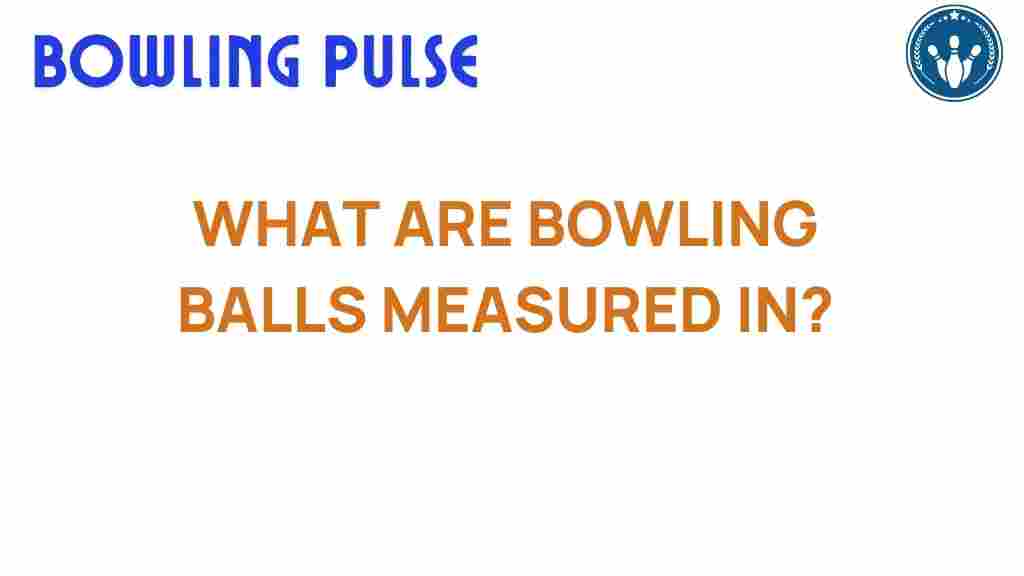Unraveling the Mystery: How Are Bowling Balls Measured?
Bowling is a sport enjoyed by millions around the world, and at the heart of the game lies the bowling ball. Understanding how bowling balls are measured is crucial for players seeking to enhance their game and improve performance. This article will delve into the intricacies of bowling ball measurement, including weight, size, specifications, and the impact these factors have on performance and dynamics. Whether you are a novice bowler or a seasoned expert, knowing how these elements come together can elevate your bowling techniques and overall experience.
The Basics of Bowling Ball Measurement
Bowling balls are measured based on several key specifications, which include:
- Weight: The heaviness of the ball, typically ranging from 6 to 16 pounds.
- Diameter: The size of the ball that usually measures about 8.5 inches.
- Coverstock: The outer material of the ball, affecting grip and friction.
- Core Type: The inner structure of the ball that influences its dynamics.
Each of these specifications plays a vital role in how the bowling ball performs on the lane. Understanding them can help bowlers choose the right equipment for their style and skill level.
How Bowling Balls Are Measured
The process of measuring bowling balls involves specific standards set by governing bodies like the United States Bowling Congress (USBC). Here’s a detailed look at how each measurement is determined:
1. Weight Measurement
The weight of a bowling ball is a critical factor that affects performance. Here’s how it’s measured:
- Bowling balls are weighed on calibrated scales to ensure accuracy.
- Weights are typically rounded to the nearest whole pound.
- Players should choose a weight that feels comfortable, often ranging from 10% to 15% of their body weight.
2. Size and Diameter
The diameter of a bowling ball is set at approximately 8.5 inches. This measurement is crucial for ensuring a proper fit in the bowling lane’s dimensions:
- Bowling balls must meet the standard diameter to be approved for sanctioned play.
- The size affects how the ball interacts with the lane surface and the pins.
3. Coverstock Composition
The coverstock is the outer layer of the bowling ball and can vary in material:
- Plastic: Ideal for beginners and straight shots.
- Urethane: Offers better hook potential and is good for intermediate players.
- Reactive Resin: Designed for advanced bowlers, providing increased friction and hook.
4. Core Dynamics
The core of the bowling ball influences its motion and stability:
- Symmetrical Cores: Provide a consistent roll and are easier to control.
- Asymmetrical Cores: Offer more angular motion and are suited for experienced bowlers.
Impact of Measurements on Performance
The measurements of bowling balls significantly affect their performance on the lanes:
- Weight: Heavier balls tend to knock down more pins due to momentum but may be harder to control.
- Size: A well-fitting ball allows for better grip and release, improving accuracy.
- Coverstock: The right material can enhance grip on the lane, affecting hook and spin.
- Core Type: The dynamics of the core can greatly influence the ball’s path and pin action.
Understanding how these specifications interact can help bowlers make informed choices about their equipment.
Choosing the Right Bowling Ball for Your Techniques
Bowling techniques vary widely among players, and selecting the right bowling ball can enhance these techniques significantly. Here are some tips on choosing the right ball:
- Assess Your Skill Level: Beginners should start with lighter, easier-to-handle balls, while advanced bowlers may opt for heavier balls with complex cores.
- Consider Your Style: If you prefer a straight shot, a plastic ball may suffice. For hook shots, consider reactive resin balls.
- Get a Proper Fit: Ensure the finger holes are drilled to match your hand’s size and grip. A professional fitting at a bowling pro shop can help.
Bowling Ball Maintenance: Troubleshooting Tips
To ensure your bowling ball performs at its best, maintenance is key. Here are some troubleshooting tips:
- Regular Cleaning: Wipe down your ball after each game to remove oil and dirt that can affect grip.
- Check for Cracks: Inspect your ball regularly for any damage; cracks can significantly impact performance.
- Rejuvenate the Coverstock: Use specialized cleaners and rejuvenators to restore the ball’s surface and maintain its grip.
- Consult Professionals: If unsure about any issues, seek advice from bowling pro shops or experienced bowlers.
Conclusion
Understanding how bowling balls are measured is an essential aspect of improving your game. From weight and size to coverstock and core dynamics, each specification influences performance and can help players refine their bowling techniques. By selecting the right equipment and maintaining it correctly, bowlers can enhance their skills and enjoy the sport even more.
For further reading on bowling techniques and equipment, check out this comprehensive guide. Remember, the right bowling ball can make all the difference in your game!
Bowling is not just about knocking down pins; it’s about understanding the nuances of your equipment, so take the time to unravel the mystery of bowling ball measurements and watch your performance soar!
This article is in the category Equipment and created by BowlingPulse Team
